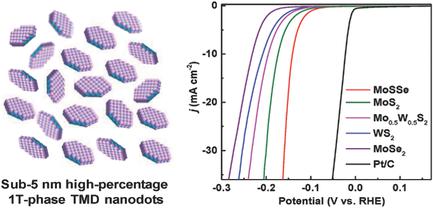当前位置:
X-MOL 学术
›
Adv. Mater.
›
论文详情
Our official English website, www.x-mol.net, welcomes your
feedback! (Note: you will need to create a separate account there.)
Preparation of High‐Percentage 1T‐Phase Transition Metal Dichalcogenide Nanodots for Electrochemical Hydrogen Evolution
Advanced Materials ( IF 27.4 ) Pub Date : 2018-01-15 , DOI: 10.1002/adma.201705509 Chaoliang Tan 1 , Zhimin Luo 1 , Apoorva Chaturvedi 1 , Yongqing Cai 2 , Yonghua Du 3 , Yue Gong 4 , Ying Huang 1 , Zhuangchai Lai 1 , Xiao Zhang 1 , Lirong Zheng 5 , Xiaoying Qi 6 , Min Hao Goh 6 , Jie Wang 1 , Shikui Han 1 , Xue-Jun Wu 1 , Lin Gu 4 , Christian Kloc 1 , Hua Zhang 1
Advanced Materials ( IF 27.4 ) Pub Date : 2018-01-15 , DOI: 10.1002/adma.201705509 Chaoliang Tan 1 , Zhimin Luo 1 , Apoorva Chaturvedi 1 , Yongqing Cai 2 , Yonghua Du 3 , Yue Gong 4 , Ying Huang 1 , Zhuangchai Lai 1 , Xiao Zhang 1 , Lirong Zheng 5 , Xiaoying Qi 6 , Min Hao Goh 6 , Jie Wang 1 , Shikui Han 1 , Xue-Jun Wu 1 , Lin Gu 4 , Christian Kloc 1 , Hua Zhang 1
Affiliation

|
Nanostructured transition metal dichalcogenides (TMDs) are proven to be efficient and robust earth‐abundant electrocatalysts to potentially replace precious platinum‐based catalysts for the hydrogen evolution reaction (HER). However, the catalytic efficiency of reported TMD catalysts is still limited by their low‐density active sites, low conductivity, and/or uncleaned surface. Herein, a general and facile method is reported for high‐yield, large‐scale production of water‐dispersed, ultrasmall‐sized, high‐percentage 1T‐phase, single‐layer TMD nanodots with high‐density active edge sites and clean surface, including MoS2, WS2, MoSe2, Mo0.5W0.5S2, and MoSSe, which exhibit much enhanced electrochemical HER performances as compared to their corresponding nanosheets. Impressively, the obtained MoSSe nanodots achieve a low overpotential of −140 mV at current density of 10 mA cm−2, a Tafel slope of 40 mV dec−1, and excellent long‐term durability. The experimental and theoretical results suggest that the excellent catalytic activity of MoSSe nanodots is attributed to the high‐density active edge sites, high‐percentage metallic 1T phase, alloying effect and basal‐plane Se‐vacancy. This work provides a universal and effective way toward the synthesis of TMD nanostructures with abundant active sites for electrocatalysis, which can also be used for other applications such as batteries, sensors, and bioimaging.
中文翻译:

制备用于电化学制氢的高百分比的1T相过渡金属二硫属化物纳米点
事实证明,纳米结构的过渡金属二硫化碳(TMDs)是高效且坚固的地球上丰富的电催化剂,可以潜在地取代用于氢气释放反应(HER)的贵重铂基催化剂。但是,已报道的TMD催化剂的催化效率仍然受到其低密度活性位,低电导率和/或未清洁表面的限制。本文报道了一种高产,大规模生产水分散的,超小型,高百分比的1T相,单层TMD纳米点的常规方法,该纳米点具有高密度的活性边缘位点和清洁的表面,包括MoS 2,WS 2,MoSe 2,Mo 0.5 W 0.5 S 2和MoSSe,与相应的纳米片相比,它们的电化学HER性能大大提高。令人印象深刻的是,所获得的MoSSe纳米点在电流密度为10 mA cm -2时的低过电位为-140 mV ,Tafel斜率为40 mV dec -1,并且具有出色的长期耐久性。实验和理论结果表明,MoSSe纳米点的优异催化活性归因于高密度的活性边缘位点,高百分比的金属1T相,合金化作用和基面硒空位。这项工作为合成具有丰富的电催化活性位点的TMD纳米结构提供了一种通用而有效的方法,该方法也可用于电池,传感器和生物成像等其他应用。
更新日期:2018-01-15
中文翻译:

制备用于电化学制氢的高百分比的1T相过渡金属二硫属化物纳米点
事实证明,纳米结构的过渡金属二硫化碳(TMDs)是高效且坚固的地球上丰富的电催化剂,可以潜在地取代用于氢气释放反应(HER)的贵重铂基催化剂。但是,已报道的TMD催化剂的催化效率仍然受到其低密度活性位,低电导率和/或未清洁表面的限制。本文报道了一种高产,大规模生产水分散的,超小型,高百分比的1T相,单层TMD纳米点的常规方法,该纳米点具有高密度的活性边缘位点和清洁的表面,包括MoS 2,WS 2,MoSe 2,Mo 0.5 W 0.5 S 2和MoSSe,与相应的纳米片相比,它们的电化学HER性能大大提高。令人印象深刻的是,所获得的MoSSe纳米点在电流密度为10 mA cm -2时的低过电位为-140 mV ,Tafel斜率为40 mV dec -1,并且具有出色的长期耐久性。实验和理论结果表明,MoSSe纳米点的优异催化活性归因于高密度的活性边缘位点,高百分比的金属1T相,合金化作用和基面硒空位。这项工作为合成具有丰富的电催化活性位点的TMD纳米结构提供了一种通用而有效的方法,该方法也可用于电池,传感器和生物成像等其他应用。











































 京公网安备 11010802027423号
京公网安备 11010802027423号